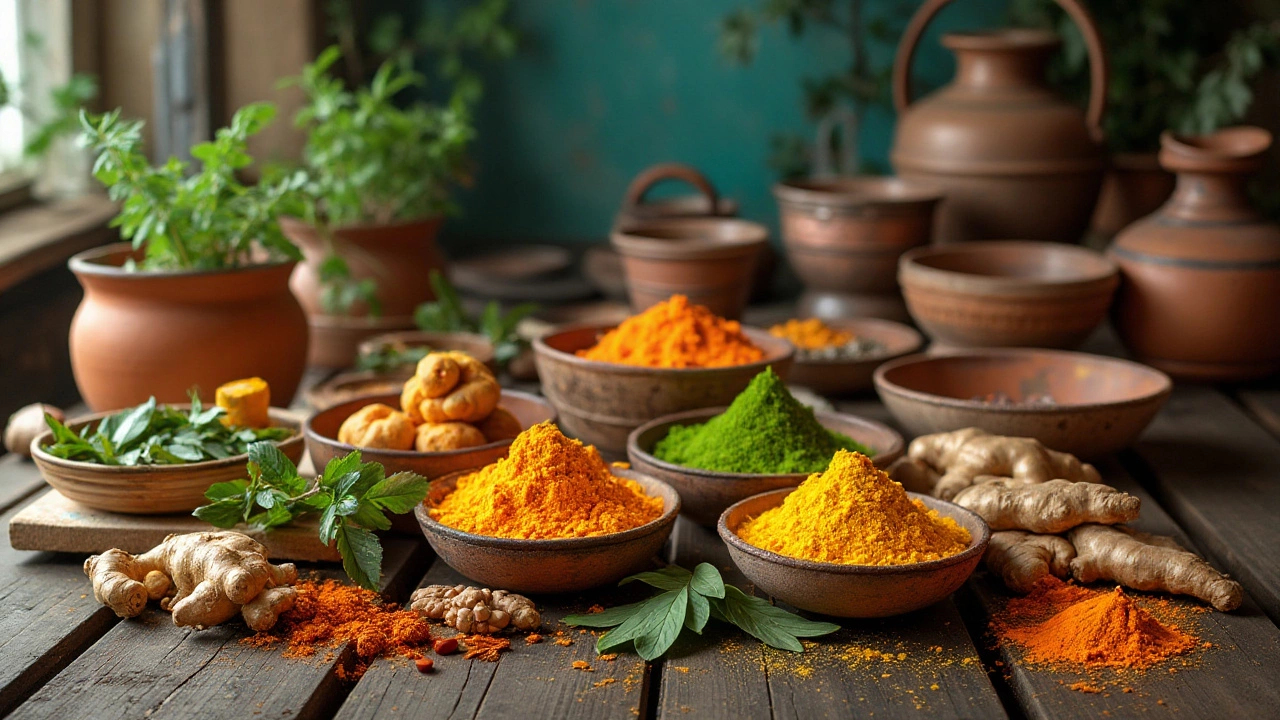
- Feb, 4 2025
- 0
Embarking on an Ayurvedic cleanse is more than just a physical detox; it's a commitment to harmonizing your body and mind with nature's timeless rhythms. Known for its personalized approach, Ayurveda invites you to delve into your unique constitution, or 'dosha,' ensuring that the cleanse compliments your individual needs.
Imagine sipping on warm herbal teas while enjoying nourishing meals that cater to your body's specific energy type. Picture incorporating daily rituals that not only cleanse but also soothe the soul, offering a complete renewal experience. If you're ready to feel rejuvenated from the inside out, an Ayurvedic cleanse might just be the key you've been missing.
- Understanding the Basics of Ayurvedic Cleansing
- Identifying Your Dosha and Tailoring the Cleanse
- Diet and Nutrition: Eating for Detoxification
- Incorporating Mindfulness and Rituals
- Maximizing the Cleanse Benefits
Understanding the Basics of Ayurvedic Cleansing
The ancient art of Ayurvedic cleansing is rooted in India's rich traditional medicine. At its core, an Ayurvedic cleanse seeks to harmonize the body's energies, remove toxins, and rejuvenate natural systems by aligning closely with the body's rhythms.
Understanding Doshas
Before embarking on a cleanse, it's essential to understand the concept of doshas. Ayurveda posits that every individual is governed by a unique balance of three primary energies, or doshas: Vata, Pitta, and Kapha. Each dosha represents different physiological functions.
- Vata: Associated with motion and air; governs breathing and mobility.
- Pitta: Relates to fire and water; responsible for digestion and metabolism.
- Kapha: Combines earth and water; controls growth and structure.
An Ayurvedic cleanse aims to balance these energies, facilitating physical and emotional wellness.
The Panchakarma Method
A well-known method for purification in Ayurveda is Panchakarma, which translates to 'five actions.' This comprehensive detox regime involves five steps designed to clear the body of accumulated toxins:
- Vamana: Therapeutic emesis to expel toxins from the stomach.
- Virechana: Purgation to cleanse the intestines.
- Basti: Herbal enemas to eliminate waste from the colon.
- Nasya: Nasal administration of medicated oils.
- Raktamokshana: Blood purification.
Not all cleanses require the full Panchakarma; adaptations are often made to fit personal constitutions and lifestyle constraints.
Why Choose an Ayurvedic Cleanse?
Unlike modern detox approaches, Ayurvedic cleansing is gentle yet effective. It empowers the body's natural abilities to heal and balance itself, which can lead to enhanced detoxification and long-lasting health benefits.
Special herbal concoctions, yoga, meditation, and a carefully planned diet are integral components, making the cleanse a holistic approach rather than just a physical purge.
Understanding the Science
A growing body of scientific evidence hints at Ayurveda's potential. For instance, a study published in the Journal of Ayurveda and Integrative Medicine demonstrated how personalized cleansing can lead to notable improvements in metabolic parameters.
By embracing an Ayurvedic cleanse, you're not just investing in physical health but also fostering a profound connection to your inner self and the world around you.
Identifying Your Dosha and Tailoring the Cleanse
The foundation of any effective Ayurvedic cleanse lies in recognizing your dosha, a unique constitution that defines your body's physiological and psychological characteristics. In Ayurveda, there are three primary doshas—Vata, Pitta, and Kapha—each derived from the five elements: space, air, fire, water, and earth. Understanding your predominant dosha is crucial as it dictates not only your physical build but also influences your tendencies and behaviors.
Discovering Your Dosha
To determine your dosha, consider factors such as your metabolic rate, emotional balance, physical attributes, and even your reaction to stress. For instance, a person with a dominant Vata dosha might exhibit traits of quick thinking but also suffer from dry skin or restlessness. In contrast, a Pitta individual may have a fiery metabolism and sharp intellect accompanied by a tendency towards irritability. The Kapha type generally features a strong, steady build but might also struggle with sluggishness.
Assess Your Dosha
- Vata: Light frame, dry skin, creative mind, variable appetite.
- Pitta: Medium build, oily skin, strong digestion, decisive, sometimes intense.
- Kapha: Solid build, smooth skin, calm demeanor, slower digestion.
You may use detailed questionnaires available through Ayurvedic practitioners or online tools to assess your dosha. Once you have pinpointed your dosha, the real task begins: tailoring the cleanse to suit your constitution.
Tailoring the Cleanse
Each dosha requires a specific approach during an Ayurvedic cleanse. The pace, type of detoxifying foods, and supportive practices all hinge on your dosha type.
- Vata
- Favor warm, moist foods like stews and cooked grains.
- Include grounding spices such as ginger and cumin.
- Balance activity with restorative practices like yoga or meditation.
- Pitta
- Opt for cooling foods like cucumber, melon, and coconut.
- Incorporate calming herbs like coriander and fennel.
- Limit exposure to direct sunlight and heat to keep the fiery nature in check.
- Kapha
- Emphasize light, dry foods such as legumes and greens.
- Spice up your meals with stimulating spices like pepper and mustard seed.
- Engage in regular exercise to counterbalance natural sluggishness.
Each tailored strategy supports your body's natural detoxification pathways, ensuring a harmonious and effective cleanse. By aligning your cleanse with your dosha, you not only enhance the detox but also prevent imbalances that could lead to discomfort or stress.
Remember, the Ayurvedic cleanse is a personalized journey. By truly understanding your dosha and its needs, you step closer to achieving balance, vitality, and renewal.

Diet and Nutrition: Eating for Detoxification
At the heart of an Ayurvedic cleanse lies a nutritional regimen that purifies the body while respecting our individual dosha, or constitution. This personalized approach is central to the practice, recommending foods that balance our unique energies. The food selections in an Ayurvedic cleanse go beyond mere sustenance—they are pivotal in eliminating toxins or 'ama' from the body and reigniting your digestive fire, or 'agni'.
Aligning with Your Dosha
Before jumping into specific diet recommendations, it’s crucial to identify your predominant dosha: Vata, Pitta, or Kapha. Each requires a tailored approach:
- Vata: Opt for warm, moist, and grounding foods such as soups, stews, and cooked grains. Sweet, sour, and salty tastes help to balance Vata.
- Pitta: Cooling and hydrating foods like cucumber, fresh juices, and salads are ideal. Sweet, bitter, and astringent foods will pacify an overheated Pitta.
- Kapha: Emphasize dry, light, and spiced ingredients. Bitter, pungent, and astringent flavors support the reduction of Kapha's heaviness.
Embracing the Seasonal Approach
A seasonal outlook is vital in Ayurvedic medicine. As the seasons shift, so too should our food selections to maintain harmony with nature’s cycles. For instance, spring calls for cleansing bitter greens and astringent spices, signaling renewal.
The Cleansing Diet
During the cleanse, introduce cooked whole grains like rice and quinoa, alongside easily digestible legumes such as mung dal. Avoid refined sugars, processed foods, and caffeine, opting instead for natural sweeteners like honey or jaggery when needed. Incorporating a range of spices including cumin, coriander, and turmeric, enhances flavor and boosts metabolism.
Hydration and Herbal Teas
A vital component of the detox process is staying adequately hydrated. Sipping warm water throughout the day aids digestion, while herbal teas like ginger and fennel soothe and balance the body. Such beverages accelerate the expulsion of toxins, promoting a gentle, yet effective cleanse.
| Common Foods | Dosha Benefits |
|---|---|
| Ginger | Enhances digestion, great for Vata and Kapha |
| Turmeric | Immunomodulatory, balances all doshas |
| Coriander | Cools Pitta, calms Vata |
In conclusion, eating for detoxification within the Ayurvedic framework is about celebrating simplicity and balance. By prioritizing wholesome, unprocessed foods, you not only cleanse your body but also lay the foundation for lasting vitality and harmony in your daily life.
Incorporating Mindfulness and Rituals
An Ayurvedic cleanse is not merely a series of dietary changes; it's an immersive experience that envelops the mind and spirit in a cloak of serenity. Rooted in the ancient traditions of India, Ayurveda recognizes that true well-being emerges from a balanced body and mind, calling for the incorporation of mindfulness and daily rituals.
Mindful Practices for Mental Clarity
Mindfulness, the practice of being present in the moment, plays a crucial role during an Ayurvedic cleanse. Consider starting your day with a brief meditation session, allowing yourself a few quiet moments to set your intentions. This simple act can steer your mind away from distractions and bring focus to the day ahead.
If meditation feels daunting, try focusing on your breath. Even a few minutes of deep, conscious breathing can instill a sense of calm and clarity. Pairing these practices with the gentle murmurs of early morning can heighten their effect, nurturing both the spirit and body.
Creating Nourishing Rituals
Rituals are the cohesive thread in the fabric of an Ayurvedic lifestyle. Start with oil pulling—a practice where swishing sesame or coconut oil in the mouth helps cleanse toxins. It’s a simple ritual, yet its benefits echo beyond dental health, reaching into overall detoxification.
Next, introduce Abhyanga, a self-massage technique using warm, herbal-infused oils. This not only softens the skin but also unlocks deep-seated tension. By indulging in this ritual daily, you are fostering a deeper connection with your body, leading to enhanced mental equilibrium.
Setting the Environment
The environment around you deeply influences your cleanse. Keep your space serene and uncluttered; consider soft lighting and calming scents using essential oils like lavender or sandalwood to create a sanctuary that encourages peace and reflection.
Engaging with Nature
Never underestimate the power of nature during a cleanse. Whether it's a gentle walk in the park or merely sitting amidst nature, such practices can root you to the earth, replenishing mental reserves while harmonizing bodily functions.
Keeping Track of Progress
| Practice | Duration | Benefits |
|---|---|---|
| Meditation | 10-15 mins | Increases focus, reduces stress |
| Oil Pulling | 5-10 mins | Detoxifies, improves oral health |
| Abhyanga | 15-20 mins | Relaxes muscles, nourishes skin |
These mindfulness practices and rituals are not just supplementary but integral components of an effective Ayurvedic cleanse. Incorporating them holistically addresses the psychosomatic aspects of health, ensuring that the cleanse is both rejuvenating and sustainable.

Maximizing the Cleanse Benefits
Completing an Ayurvedic cleanse is an empowering achievement, but to truly reap its benefits, it’s crucial to pay attention to the period immediately following the detox. This phase is pivotal for integrating the cleanse into your lifestyle and avoiding the pitfalls of quickly reverting to old habits.
Gradual Reintegration of Foods
One of the first steps is to gradually reintroduce your regular foods. Let your digestive system acclimatize by adding new foods slowly. Start with lighter foods such as steamed vegetables, soups, and grains before moving to more complex meals. This approach allows your body to absorb nutrients effectively after a period of detoxification.
Prioritize Whole Foods
Makesuretofocus on whole foods that are minimally processed. These include fresh fruits, vegetables, nuts, and seeds. By giving preference to natural foods, you continue to support your body's natural detox mechanisms and maintain the vibrancy achieved during the detox.
Mindfulness and Meditation
Post-cleanse isn't only about physical nourishment; mental and spiritual well-being are equally essential. Incorporate mindfulness practices such as meditation and yoga to help sustain the sense of balance cultivated during the cleanse. A daily 10-minute mindfulness practice can significantly enhance your sense of well-being and reduce stress.
Staying Hydrated
Water plays a crucial role in maintaining the cleanse benefits. Consistent hydration supports digestion, circulation, and temperature regulation. Aim to drink warm herbal teas, like ginger or chamomile, which help in maintaining the internal harmony established during the cleanse.
Establishing Supportive Habits
Lasting change comes from building a supportive daily routine. This might include a morning ritual of warm water with lemon, a midday walk to refresh your mind, or an evening practice of journaling your thoughts. These small, manageable habits collectively uphold the transformation initiated by the cleanse.
Tracking Your Progress
To stay motivated, consider keeping a progress tracker. Record your feelings, energy levels, digestion, and any changes in mood or complexion. Seeing tangible evidence of the cleanse benefits encourages continued engagement with Ayurvedic principles.
By embedding these practices into your routine, you not only maximize the benefits of the Ayurvedic cleanse but potentially transform your overall lifestyle into one that cherishes balance and harmony. Doing so paves the way for a healthier, more vibrant version of yourself.
Nikhil Verma
I'm a dedicated physician with a passion for exploring the intricacies of medicine, focusing on the unique healthcare challenges in India. I spend much of my spare time writing articles aimed at improving public understanding of health issues. Balancing my clinical practice and writing allows me to reach a wider audience, sharing insights and fostering a deeper appreciation for medical advancements. I derive immense satisfaction from both treating patients and engaging with readers through my writing.